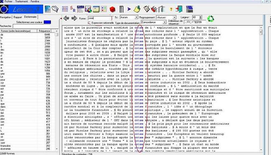Lexico
Lexico
Developed by: Equipe SYLED-CLA2T, Université de la Sorbonne Nouvelle, Paris 3
License: Commercial&Closed source
Web page : Tool homepage
Tool type : Application software
The last edition of this page was on: 2014/11/18
The Completion level of this page is : Low
The last edition of this page was on: 2014/11/18 The Completion level of this page is : Low
SHORT DESCRIPTION
[[has description::Quote from the Home page: “Lexico3 is the 2001 edition of the Lexico software, first published in 1990. Functions present from the first version (segmentation, concordances, breakdown in graphic form, characteristic elements and factorial analyses of repeated forms and segments) were maintained and for the most part significantly improved. The Lexico series is unique in that it allows the user to maintain control over the entire lexicometric process from initial segmentation to the publication of final results. Beyond identification of graphic forms, the software allows for study of the identification of more complex units composed of form sequences: repeated segments, pairs of forms in co-occurrences, etc which are less ambiguous than the graphic forms that make them up.”
A free version is available for "personal work", bottom of this page]]
TOOL CHARACTERISTICS
Usability
Tool orientation
Data mining type
Manipulation type
IMPORT FORMAT :
EXPORT FORMAT :
| Tool objective(s) in the field of Learning Sciences | |
|
☑ Analysis & Visualisation of data |
☑ Providing feedback for supporting instructors: |
Tool can perform:
- Data extraction of type:
- Transformation of type:
- Data analysis of type: Data mining methods and algorithms
- Data visualisation of type: (These visualisations can be interactive and updated in "real time")
ABOUT USERS
Tool is suitable for:
Required skills:
STATISTICS: N/A
PROGRAMMING: N/A
SYSTEM ADMINISTRATION: N/A
DATA MINING MODELS: N/A
FREE TEXT
| Tool version : Lexico (blank line) Developed by : Equipe SYLED-CLA2T, Université de la Sorbonne Nouvelle, Paris 3 | 
|
Contents
SHORT DESCRIPTION
Quote from the Home page: “Lexico3 is the 2001 edition of the Lexico software, first published in 1990. Functions present from the first version (segmentation, concordances, breakdown in graphic form, characteristic elements and factorial analyses of repeated forms and segments) were maintained and for the most part significantly improved. The Lexico series is unique in that it allows the user to maintain control over the entire lexicometric process from initial segmentation to the publication of final results. Beyond identification of graphic forms, the software allows for study of the identification of more complex units composed of form sequences: repeated segments, pairs of forms in co-occurrences, etc which are less ambiguous than the graphic forms that make them up.”
A free version is available for "personal work", bottom of this page
TOOL CHARACTERISTICS
| Tool orientation | Data mining type | Usability |
|---|---|---|
| This tool is designed for general purpose analysis. | This tool is designed for Text mining. | Authors of this page consider that this tool is . |
| Data import format | Data export format |
|---|---|
| . | . |
| Tool objective(s) in the field of Learning Sciences | |
|
☑ Analysis & Visualisation of data |
☑ Providing feedback for supporting instructors: |
Can perform data extraction of type:
Can perform data transformation of type:
Can perform data analysis of type:
Data mining methods and algorithms
Can perform data visualisation of type:
(These visualisations can be interactive and updated in "real time")
ABOUT USER
| Tool is suitable for: | ||||
| Students/Learners/Consumers:☑ | Teachers/Tutors/Managers:☑ | Researchers:☑ | Organisations/Institutions/Firms:☑ | Others:☑ |
| Required skills: | |||
| Statistics: | Programming: | System administration: | Data mining models: |
OTHER TOOL INFORMATION

|
| lexico3.png |
| LexicoLOGO.gif |
| Lexico |
| Commercial&Closed source |
| Equipe SYLED-CLA2T, Université de la Sorbonne Nouvelle, Paris 3 |
| http://www.tal.univ-paris3.fr/lexico/ |
| [[has description::Quote from the Home page: “Lexico3 is the 2001 edition of the Lexico software, first published in 1990. Functions present from the first version (segmentation, concordances, breakdown in graphic form, characteristic elements and factorial analyses of repeated forms and segments) were maintained and for the most part significantly improved. The Lexico series is unique in that it allows the user to maintain control over the entire lexicometric process from initial segmentation to the publication of final results. Beyond identification of graphic forms, the software allows for study of the identification of more complex units composed of form sequences: repeated segments, pairs of forms in co-occurrences, etc which are less ambiguous than the graphic forms that make them up.”
A free version is available for "personal work", bottom of this page]] |
| General analysis |
| N/A |
| N/A |
| N/A |
| N/A |
| Application software |
| Text mining |
| Data transformation, Data analysis, Data visualisation, Data conversion, Data cleaning |
| Data mining methods and algorithms |
| Low |
Links
Lebart, L. & Salem, A. (1994). Statistique Textuelle, Dunod, 344 p. Epuisé, accessible en ligne, http://www.tal.univ-paris3.fr/lexico/
Bugs
Does not install on Windows 8 (even in Win XP compatibility mode)

